In RenewAmerica
Abstract: Due to clergy sex abuse scandals centered primarily in
the Northern hemisphere, the moral authority of the Roman Catholic
Church has been subjected to an opportunistic siege by prominent
individuals and organizations who see the chance to advance their goals,
including the ordination of women and the suspension of the requirement
for priestly celibacy.
There is also a strongly defensive element to this strategy. Opponents
of the Church know that there is a well-documented and strong
correlation between male homosexuality and child sexual abuse, but claim
that there is no evidence supporting this connection.
And, of course, those who are currently attacking the Church hope that
they can undermine its moral authority to preach on the sinfulness of
homosexual behavior and weaken its opposition to ersatz homosexual
"marriage."
This paper demonstrates that there is indeed a very strong link between
male homosexuality and child sexual abuse. It also shows that there is a
similar rate of child sexual abuse among other very large groups of
adult males (e.g., Protestant clergy, who are usually married), thus
proving that celibacy is not the root of the problem — homosexuality is.
Introduction
A very small number of Catholic priests and other leaders have taken
advantage of their positions of authority and influence in order to gain
sexual favors or to take advantage of the helpless. The problem of
clerical child sexual molestation, particularly in the United States and
Europe, has been widely exposed and publicized over the past decade.
During the crisis currently being discussed, homophile activists within
and outside the Catholic Church have done everything they can to divert
attention away from even the
possibility that there may be a
higher percentage of homosexuals among the priesthood than in the
general public, and that this may be the root cause of the problem of
child sexual molestation within the Church. These activists
particularly seek to deny the link between homosexuality and child
sexual molestation.
For example, the dissenting organization "Dignity USA" kicked off its
"Stop Blaming Gay Priests" campaign in 2002. The group said "DigntyUSA
[sic] is calling on the U.S. Catholic bishops to stop blaming gay
priests for the clergy sexual abuse scandal. All credible evidence
discounts any link between the molestation of children and
homosexuality."
[1]
More recently, Tarcisio Cardinal Bertone, the Holy See's Secretary of
State, suggested that there is a link between homosexuality and child
sexual abuse. "Gay" groups all over the world reacted with horror and
fury, and echoed what Dignity USA had said years before. As one
example, Rolando Jiminéz, president of Chile's Movement for Homosexual
Integration and Liberation, said that "No reputable study exists to
support the cardinal's claims."
[2]
The situation has become so charged that anyone who even
suggests
that there may be a connection between homosexuality and child sexual
abuse is instantly and reflexively labeled a "homophobe" and a "gay
basher." The powerful homosexual lobby reacts instinctively to negative
publicity and information by "ritually defaming" those who dare raise
their voices. Organized homosexual groups and their supporters first
attempt to ignore the evidence, or, if it simply cannot be disregarded,
aggressively smear and discredit those who produced it.
[3]
Such wholesale dismissal of documented facts, and the accompanying refusal to even
discuss
the possibility of a link between an active homosexual lifestyle and
child sexual abuse, is a grave disservice not only to the victims, but
to society at large. Obviously, a proven link between homosexual
orientation and child sexual molestation would badly damage the
carefully crafted public relations image of the "gay rights" movement.
Therefore, instead of calmly and rationally discussing the issues,
homosexual rights leaders subscribe to the axiom "the best defense is a
good [and loud] offense." They remain in a permanent attack mode.
In general, the media and liberal groups seem almost pathologically
careful to avoid stereotyping an entire group of people because of the
actions of just a few. For example, we are told repeatedly that we must
not perceive jihadists as representing Islam. Yet, when dealing with
the Catholic Church, the media and others cast even the vestiges of
decency and restraint to the wind. As one example, a writer described
the Vatican as "an international criminal conspiracy to protect child
rapists."
[4] Naturally, the Pope is singled out for the most vicious and ridiculous abuse. According to
The Irish Times,
"Pope Benedict has made worse just about everything that is wrong with
the Roman Catholic Church and is directly responsible for engineering
the global cover-up of child rape perpetrated by priests."
[5]
The only way to get at the root of the problem of priestly child
molestation is to ignore this smear campaign and proceed methodically.
We must first objectively study all facts relating to the situation, and
then muster the courage to respond by taking the appropriate steps. If
this is not done, any effort to address the problem, no matter how well
intentioned or vigorously pursued, will be utterly squandered.
Certainly we owe it to the victims — and to the Catholic Church itself — to determine the truth behind this volatile topic.
Studies on the Frequency of Homosexual Child Molestation
Dignity USA and other homosexual groups strenuously deny any connection
whatever between a homosexual orientation and child sexual molestation.
They repeatedly claim that "All credible evidence discounts any link
between the molestation of children and homosexuality."
[6]
Yet these groups seem curiously reluctant to cite this "credible evidence."
In fact, a number of studies performed over a period spanning more than half a century —
many of which were performed by homosexuals or their sympathizers — have shown that an extremely large percentage of sexually active homosexuals also participate in child sexual molestation.
This is not "homophobia" or "hatred." This is mere scientific
fact.
For example:
- Homosexual Alfred Kinsey, the USA's preeminent sexual researcher,
found in 1948 that 37 percent of all male homosexuals admitted to having
sex with children under 17 years old. [7]
- A recent study published in the Archives of Sexual Behavior
found that "The best epidemiological evidence indicates that only 2 -
4% of men attracted to adults prefer men. In contrast, around 25 - 40%
of men attracted to children prefer boys. Thus, the rate of homosexual
attraction is 6-20 times higher among pedophiles." [8]
- Another recent study in the Archives of Sexual Behavior
found that "... all but 9 of the 48 homosexual men preferred the
youngest two male age categories." These age categories were fifteen
and twenty years old. [9]
- A third study in the Archives of Sexual Behavior found
that "Pedophilia appears to have a greater than chance association with
two other statistically infrequent phenomena. The first of these is
homosexuality ... Recent surveys estimate the prevalence of
homosexuality, among men attracted to adults, in the neighborhood of 2%.
In contrast, the prevalence of homosexuality among pedophiles may be
as high as 30 - 40%." [10]
- A study in the Journal of Sex Research noted that "...
the proportion of sex offenders against male children among homosexual
men is substantially larger than the proportion of sex offenders against
female children among heterosexual men ... the development of
pedophilia is more closely linked with homosexuality than with
heterosexuality." [11]
- A study of 229 convicted child molesters published in the Archives of Sexual Behavior found that "eighty-six percent of [sexual] offenders against males described themselves as homosexual or bisexual." [12]
- A study by The Institute for Sex Research, which was founded by
Alfred Kinsey, determined that 25% of white homosexual men have had sex
with boys sixteen years and younger. [13]
There are occasional desultory attempts to deny or obscure the fact that
a disproportionately high percentage of active homosexuals sexually
molest children. These studies are invariably afflicted with one or
more fatal flaws.
A typical example, oft quoted by "gay rights" activists, is the July 1994
Pediatrics
article by Jenny, Roesler and Poyer that says "Using the data from our
study, the 95% confidence limits of the risk children would identify
recognizably homosexual adults as the potential abuser, are from 0% to
3.1%. These limits are within current estimates of the prevalence of
homosexuality in the general community."
[14]
The fatal flaw of this study is that it examined sexually abused
children with a mean age of just 6.1 years. Children this young are
usually targets of true pedophiles, those persons with no sexual
attraction to adults of either sex. By contrast, homosexual pedophiles
are usually classified as "ephebophiles," persons sexually attracted to
pubescent or post pubescent children.
Definitions and Calculations
The John Jay study on the sexual abuse crisis in the Catholic Church in
the United States defines "pedophiles" as people who "exhibit recurrent,
intense, sexually arousing fantasies, urges or behaviors related to
sexual contact with a prepubescent child over a period of at least six
months duration."
[15]
When people speak of the current crisis being a problem involving
"pedophile priests," they are addressing only a small portion of the
situation. According to the John Jay study, most of the sexually
offending priests are not true pedophiles. They are in fact
"ephebophiles," who "exhibit these same fantasies, urges or behaviors
towards post pubescent youths."
[16]
Generally, the John Jay study recognized that pedophilia can be
defined as the sexual molestation of children aged ten and younger. The
National Review Board study defines "ephebophilia" as "homosexual
attraction to adolescent males," a definition that certainly is
validated by the quotes of "gay rights" activists later in this article.
[17]
Table 3.5.4 of the John Jay Study is reproduced below. It clearly
demonstrates that, as the age of the victims rises, the percentage of
victims decisively shifts from primarily female to overwhelmingly male.

The results shown in Table 3.5.4 stand in stark contrast to United
States Department of Health and Human Services statistics, which show
that male on male child sexual abuse in the USA comprises only 14.4% of
all sexual abuse committed by males. In other words, in the general
population of males who sexually abuse minors, only
one in seven molest boys. In the population of priests who sexually abuse minors,
six in seven molest boys.
[18]
Figure 1 graphically depicts Table 3.5.4, and shows the numbers of
alleged victims of sexual abuse incidents grouped by gender and age.
One can clearly see that the percentage of victims is overwhelmingly
male.
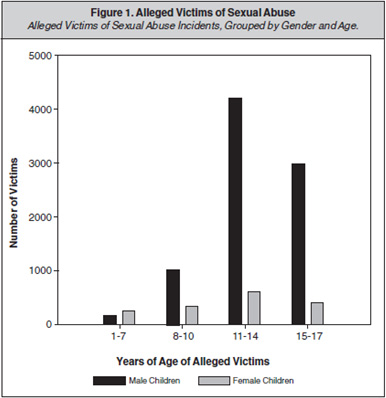
Many experts have claimed that there is a much higher percentage of
homosexuals in the priesthood than there is in the general population.
Let us assume for a moment that the concentration of male homosexuals in
the priesthood is four times greater than it is in the general
population — about ten percent.
[19]
If we assume that this number is correct, using the figures given in Table 3.5.4, we find that a homosexual priest is
(85.3%/10.0%)/(14.7%/90.0%) = 52
times more likely to molest a child than a heterosexual priest.
If we use the more reasonable assumption that five percent of all
priests are homosexual (still about twice the average in the general
population), we see that a homosexual priest is
(85.3%/5.0%)/(14.7%/95.0%) = 110
times more likely to molest a child than a heterosexual priest.
It is logical that homosexuals who sexually desire young children
deliberately seek employment that will bring them into proximity with
the greatest number of children possible. The most "promising" jobs of
this nature include clergymen working in youth ministries, Boy Scout
leaders and schoolteachers.
This is primarily why homosexual teachers have been involved in a hugely
disproportionate number of all recorded cases of teacher/pupil sex. A
nationwide survey of school principals showed that they received 13
times as many complaints about homosexuals sexually molesting students
than they did about heterosexuals molesting students.
[20]
Other studies have shown that homosexual teachers are from 90 to 100
times more likely to molest students than heterosexual teachers.
[21]
Supporting Quotes by Homosexual Activists
As further evidence of the strong connection between active
homosexuality and child molestation, many homosexual leaders have openly
admitted that there is a natural link between a homosexual orientation
and child sexual abuse.
Many "gay" organizations and leaders not only admit to, but
support, the sexual abuse of children by homosexuals.
An editorial in the
San Francisco Sentinel, a member of the National Lesbian & Gay Journalist's Association, claimed that
The love between men and boys is at the foundation of homosexuality.
For the gay community to imply that boy love is not homosexual love is
ridiculous. We must not be seduced into believing misinformation from
the press and the government. Child molesting does occur, but there are
also positive sexual relations. And we need to support the men and the
boys in those relationships. [22]
The notorious North American Man Boy Love Association (NAMBLA), one of
several major organized pederast groups, always has a drawing or a photo
of a pre teen boy on the cover of its NAMBLA
Bulletin, as well as many other such depictions within each issue.
Pedophile Philip Hutchinson's poem entitled "Choirboy" is entirely typical of the fare found in the
Bulletin;
You look like a cherub, but you're worldly wise.
You'd love to have me think you're newly born,
but I can spot the twinkle in your eyes;
you know damned well how much you turn me on.
Between us, you're the satyr — I'm the saint,
so shed your sacred robe and bare your skin,
surrender to my touch without restraint,
and later, put your halo on again. [23]
One of NAMBLA's flyers says that:
There is no age at which a person becomes capable of consenting to sex.
The age of sexual consent is just one of many ways in which adults
impose their system of control on children ... Amazing as it may seem in
this child hating and homophobic society, boy lovers find boys
attractive and like their spontaneity and openness. [24]
Pederast and NAMBLA member David Thorstad has said that "I think that
pederasty should be given the stamp of approval. I think it's true that
boy lovers are much better for children than the parents are ..."
[25]
NAMBLA is by no means on the fringe of the "gay rights" movement. For
years, it was a member in good standing of the International Lesbian and
Gay Association (ILGA), and was only jettisoned by ILGA when the parent
organization applied for United Nations consultative status in 1993.
Years earlier, the ILGA itself had resolved that "Young people have the
right to sexual and social self determination and that age of consent
laws often operate to oppress and not to protect."
[26]
Homosexual defenders of NAMBLA declared that "man/boy love is by
definition homosexual," that "man/boy lovers are part of the gay
movement and central to gay history and culture," part of "the Western
homosexual tradition from Socrates to Wilde to Gide," and part of "many
non Western homo sexualities from New Guinea and Persia to the Zulu and
the Japanese."
[27]
In fact, one of NAMBLA's "gay" defenders got right to the point when he
said that "Homosexuals denying that it is 'not gay' to be attracted to
adolescent boys are just as ludicrous as heterosexuals saying it's 'not
heterosexual' to be attracted to adolescent girls."
[28]
"Gay" leaders and researchers have recognized and publicized the natural
relationship between homosexuality and pederasty [adult male sexual
molestation of boys] for decades. NAMBLA and similar groups may be in
the forefront of promoting "gay" sex with young boys, but many other
prominent homosexuals have transmitted the same message;
- Larry Kramer, founder of the homosexual group AIDS Coalition to
Unleash Power (ACT UP), said that "In those cases where children do have
sex with their homosexual elders, I submit that often, very often, the
child desires the activity, and perhaps even solicits it, either because
of a natural curiosity, or because he or she is homosexual and innately
knows it. ... And unlike girls or women forced into rape or
traumatized, most gay men have warm memories of their earliest and early
sexual encounters; when we share these stories with each other, they
are invariably positive ones." [29]
- Pat Califia, lesbian author and activist, wrote in the "mainstream" homosexual publication The Advocate
that "Boy lovers and the lesbians who have young lovers are the only
people offering a hand to help young women and men cross the difficult
terrain between straight society and the gay community. They are not
child molesters. The child abusers are priests, teachers, therapists,
cops and parents who force their stale morality onto the young people in
their custody. Instead of condemning pedophiles for their involvement
with lesbian and gay youth, we should be supporting them." [30]
- Steve Hanson wrote in the homosexual magazine Bay Area Reporter
"Shame on us if our lesbian/gay voices remain silent while our NAMBLA
brothers are persecuted once again, and shame on those lesbians and gay
men who will raise their voices to condemn NAMBLA, insisting that boy
lovers (and presumably the boys they love and who love them) are not
part of this thing called the lesbian/gay community." [31]
- One of the authors of The Big Gay Book said that "Sex
between youths and adults is one of the most difficult issues in the gay
movement. When does a youngster have the right and the power to make
his own sexual decisions? How are laws against intergenerational sex
used specifically to target gay men? What are the issues that make the
romantic image of the Greek teacher and his student in times of
antiquity turn into something ugly and forbidden in the modern age?" [32]
- Lesbian Gayle Rubin wrote that "The recent career of boy love
in the public mind should serve as an alert that the self interests of
the feminist and gay movements are linked to simple justice for
stigmatized sexual minorities. ... We must not reject all sexual contact
between adults and young people as inherently oppressive." [33]
Like the "ten percent" myth, the modern-day concept that adults can
legitimately have sex with children originated with the Alfred Kinsey
team. Sex educator and Kinsey collaborator Wardell Pomeroy said that
"People seem to think that any [sexual] contact between children and
adults has a bad effect on the child. I say that this can be a loving
and thoughtful, responsible sexual activity."
[34]
Interestingly, while the mainstream press and liberal groups
systematically pillory the Catholic Church, they entirely ignore the
well organized and determined efforts by professional associations to
decriminalize and normalize child sexual abuse.
For example, the American Psychiatric Association (APA) recently
sponsored a symposium in which participants discussed the removal of
pedophilia from an upcoming edition of the group's psychiatric manual of
mental disorders. At about the same time, the
Archives of Sexual Behavior published a special edition in December 2002 discussing whether pedophilia should remain classified as a mental disorder.
[35]
As early as 1988, a leading American psychological journal,
Behavior Today,
claimed that "Pedophilia may be a sexual orientation rather than a
sexual deviation. This raises the question as to whether pedophiles may
have rights."
[36]
Information Provided by a Diocesan Administrator
It is clear, even without reference to the numerous reports throughout
the recent years, that homosexuals have infiltrated the ranks of the
clergy to an astonishing degree. In some corners of the Church, such
behavior has long been seen as acceptable.
To cite just one recent example, Msgr. Richard Sniezyk, appointed to
head the Diocese of Springfield in Massachusetts after its bishop
resigned amid sexual abuse allegations, said in an interview that the
recent scandal in the Catholic Church stems from a belief among some
priests during the 1960s, 1970s, and 1980s that sex with young men was
"acceptable;"
Monsignor Richard S. Sniezyk, 66, the leader of the Springfield Diocese
until the Vatican names a bishop to replace Thomas L. Dupre, said that
as a seminarian and then a young priest ... he heard of priests who had
sex with young men, but "no one thought much about it" because priests
didn't recognize how mentally and emotionally damaging their behavior
was ... "It was that era of the '60s — most of it took place from the
mid '60s to the early' 80s — and the whole atmosphere out there was, it
was OK, it was OK to do." [37]
This is not a statement by an anti Catholic or homosexual activist, but
rather an admission from none other than the duly appointed shepherd of
souls in this Massachusetts diocese.
It is easy to look back on the crisis in the Catholic Church in the
United States and place blame on the Vatican, on the bishops, on the
seminaries, or even on our society's permissive attitude toward
sexuality in general. But much terrible damage has already been done —
to the victims, to the Church, and to the souls of many whose faith has
been shaken or even destroyed by the scandal.
Our primary responsibilities at this point are not blame and
condemnation, but reparation and prevention. We must compensate the
victims, and we must reassure them by making certain that there are no
more future cases of child sexual molestation by clergy or other Church
workers.
Does Pederast Equal "Gay"?
Some researchers assert that just because an activity is homosexual in
nature does not mean that the person committing the act is a homosexual.
For example, criminologist Margaret Smith said that "The majority of
the [clergy] abusive acts were homosexual in nature. That participation
in homosexual acts is not the same as sexual identity as a gay man."
[38]
This is like saying that someone who steals is not a thief, or that
someone who races his car down a crowded city street at 200 kilometers
per hour is not a reckless driver.
Men who sexually molest boys may
claim not to be homosexual, but this assertion is disingenuous at best and deliberately deceptive at worst.
Many of the studies quoted above show that homosexual men are attracted to young boys. An
Archives of Sexual Behavior
study compared the sexual age preferences of people who described
themselves as heterosexual men, heterosexual women, homosexual men, and
lesbians. The results showed that "all but 9 of the 48 homosexual men
preferred the youngest two male age categories," which included males as
young as age fifteen.
[39]
Sometimes homophile groups allege that men who sexually molest boys are
generally not sexually attracted to adult males, and therefore should
not be considered homosexuals.
Once again, research does not support such a claim. A study of sex offenders against male children in
Behavior Research and Therapy
found that male pederasts are sexually attracted to "males of all
ages." Compared to non offenders, the offenders showed "greater
arousal" when viewing slides of nude males as old as twenty four: "As a
group, the child molesters responded with moderate sexual arousal ...
to the nude males of all ages."
[40]
In fact, a large percentage of pedophiles consider themselves to be
homosexual. A study of 229 convicted child molesters in the
Archives of Sexual Behavior found that "eighty six percent of [sexual] offenders against males described themselves as homosexual or bisexual."
[41]
Is Celibacy the Problem?
Many opportunists claim that, if the Catholic Church would simply relax
its rules on celibacy, the sexual abuse crisis would be greatly
ameliorated.
This assertion simply makes no sense.
Those priests who sexually molest boys have just as much access to adult
women as other men. In fact, since priests are admired and respected
professionals, we might reasonably say that they have
more ready access to women than do other men.
The most certain proof that there is no correlation between celibacy and
child molestation comes from the fact that married men commit child
sexual abuse at about the same rate as Catholic priests.
There are about 260 reports each year of children under 18 being
sexually abused by Protestant clergy, church staff, volunteers or
congregation members. By comparison, 4,392 priests (out of 109,000)
were accused of sexual abuse during the time period 1950 to 2002, an
average of 84 per year.
[42]
These numbers are backed up by a comprehensive study by Professor Philip
Jenkins of Penn State, which found that between 0.2 percent and 1.7
percent of priests are pedophiles, and 2 to 3 percent of Protestant
clergy are pedophiles, a somewhat higher rate.
[43]
Since Protestant clergy are free to marry, it is obvious that allowing priests to marry will not solve the problem.
"Born that Way?" So What?
We often hear from the homosexual rights movement that "gays" are "born
that way." This may or may not be true, depending on which of the
hundreds of conflicting studies we choose to believe. Some experts
believe that, in many cases, homosexuality is an acquired condition due
to the lack of an effective male role model.
In the most fundamental sense, this point is irrelevant. We are
all born with weaknesses, a direct result of our fallen natures.
We can deal with these weaknesses in one of two ways. We can accept them
as crosses given to us by God, and we can glorify His Name by
struggling to overcome them with the aid of His grace. Or we can simply
give in and use the "born that way" excuse, the weak and cowardly road
that is a vote of no confidence in God's grace and its ability to save
us.
A person can have a genetic predisposition towards alcoholism. Yet our
spouses do not accept the "born that way" excuse if we arrive home drunk
every night. Kleptomania may indeed also be genetic, yet no court in
the world has ever accepted the "born that way" excuse as a defense
against shoplifting charges.
Alcoholics and those tempted to steal can be good and holy priests —
just so long as they recognize their weaknesses, avoid near occasions of
sin, and fight to overcome them on a daily basis with the help of God's
grace. Men who are sexually attracted to women or to other men can
also become saintly priests — but only if they do not give in to
temptation and act out their desires.
A man who is living an active homosexual lifestyle, or who even
experiences homosexual tendencies, should never be ordained a priest.
[44] The danger to souls and to lives is just too great, as the sexual abuse crisis in the Church has amply demonstrated.
Conclusions
Ephebophilia, or the sexual desire for adolescent boys, has always been a
hallmark of homosexuality, as shown by numerous scientific studies, and
as admitted by "gay" leaders themselves on many occasions.
Homophile groups are exploiting the current crisis in the Church in
order to achieve their goals, a classic strategy of infiltration and
subversion. Many of these groups vocally supported "man-boy love" in
the 1960s and 1970s. Now the same groups are attacking the Church
because pedophile priests followed their advice and became "boy-lovers!"
The primary goal of those attacking the Church is to publicly destroy
its moral authority so that people will not heed its teachings that
homosexual behavior is sinful, and that homosexual "marriage" is a
fraud.
A secondary goal of these groups is to eliminate the requirement for
celibacy among priests. However, married Protestant clergy have a
larger rate of child sexual molestation as Catholic priests, proving
that celibacy has nothing at all to do with pederasty.
In summary, there are many attacking on the Pope specifically and the
Roman Catholic Church generally because of the sex abuse crisis.
However, these individuals and organizations are not motivated by a
desire to enlighten mankind or protect the innocent, since the crisis
has already largely subsided, and stringent means have been enacted to
prevent the abuse from reoccurring. Rather, the motivation appears to
be more one of bigotry and a desire to muzzle and sideline the Church's
moral opposition to the "gay rights" movement.
The Author
Brian W. Clowes, Ph.D., is a 1974 graduate of the United States
Military Academy at West Point. In 1995 he became the Director of
Research and Training for Human Life International. He has written and
edited eleven books and over one hundred articles in several fields of
discipline. Dr. Clowes, his wife Kathy, and their seven children live
in Front Royal, Virginia.
APPENDIX
PAGE IMAGES FROM SELECTED MEDICAL
PUBLICATIONS CITED IN THE TEXT
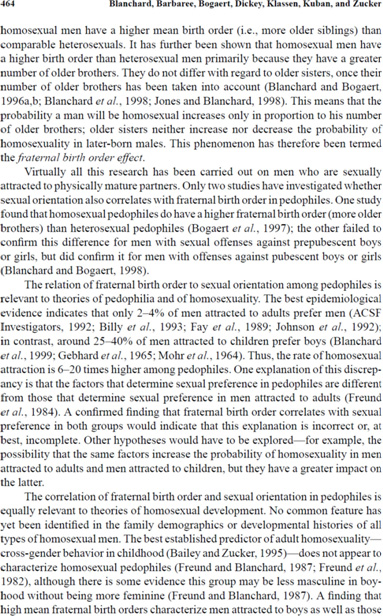
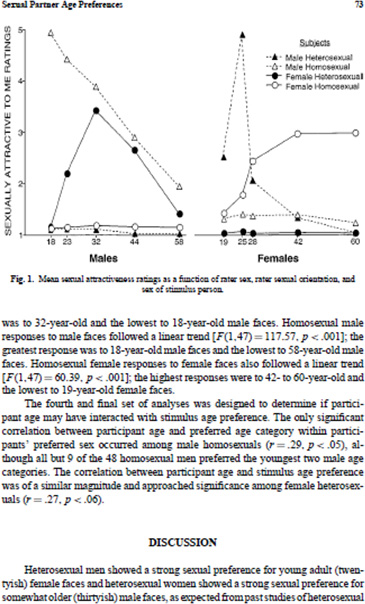
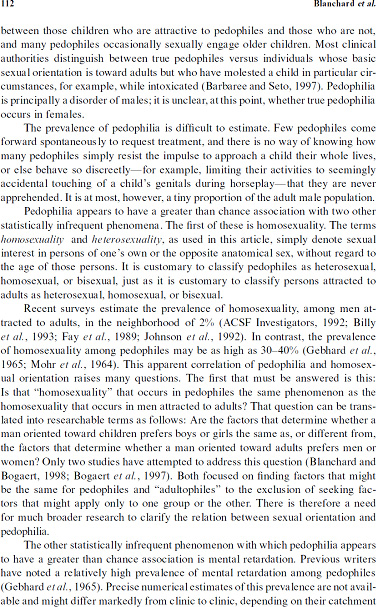
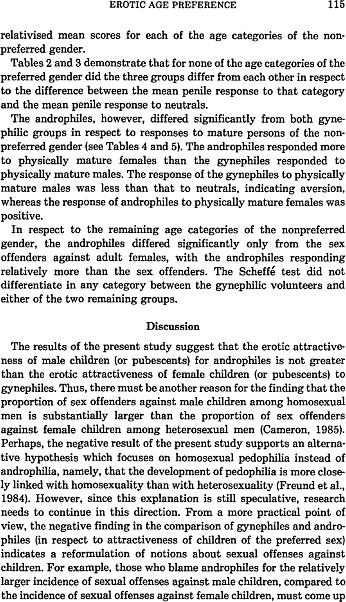
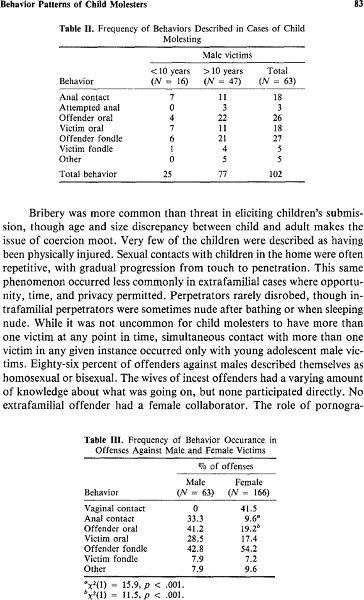
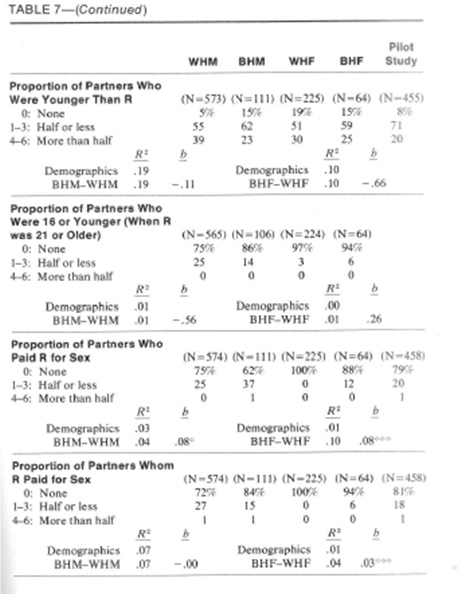 NOTES:
NOTES:
[1]
Dignity USA Web site, February 6, 2004. This campaign was begun during
the United States Conference of Catholic Bishops annual meeting in
Washington, D.C., November 10 13, 2002. We should point out that the
very existence of a group that supports sexually active "gay priests" is
a great source of scandal.
[2] Rory Carroll. "Vatican Attacked over Cardinal's Claim of Homosexuality and Paedophilia Link."
The Guardian, April 13, 2010.
[3]
Laird Wilcox. "The Practice of Ritual Defamation." Editorial Research
Service Web site at http://www.lairdwilcox.com. Homophiles will
inevitably use these tactics in attempts to discredit this report.
Defenders of the Catholic Church must ignore these attacks and emphasize
the quotes, statistics and conclusions contained in this work.
[4]
Perhaps the best general article on the bigotry of the "Pope-hunters"
is by atheist Brendan O'Neill. "The Pope-Hunters' Pathological
Campaign."
The Australian, April 15, 2010.
[5] Hans Küng. "Church in Worst Credibility Crisis since Reformation, Theologian Tells Bishops."
The Irish Times, April 16, 2010.
[6] Dignity USA Web site, February 6, 2004.
[7] Alfred Kinsey data described in P.H. Gebhard and A.B. Johnson.
The Kinsey Data.
Saunders Publishing, 1979. Table 443, "Homosexual Sample: Age at
First Postpubertal Homosexual Contact," and Table 444, "Homosexual
Sample: Age of Partner in First Postpubertal Homosexual Contact." Even
though much of Kinsey's research has been thoroughly discredited, his
enduring primacy in the field of 'sexology' means that sex educators and
others involved in human sexuality study his material intensively, and
have therefore been aware of the strong link between homosexuality and
pedophilia for more than six decades.
[8] Ray Blanchard,
et al. "Fraternal Birth Order and Sexual Orientation in Pedophiles."
Archives of Sexual Behavior, October 2000 [Volume 29, Number 5], pages 463-478, p. 464.
[9]
A. Zebulon, Z.A. Silverthorne and Vernon L. Quinsey. "Sexual Partner
Age Preferences of Homosexual and Heterosexual Men and Women."
Archives of Sexual Behavior, February 2000 [Volume 29, Number 1], pages 67-76, p. 73.
[10] Ray Blanchard,
et. al. "Pedophiles: Mental Retardation, Maternal Age, and Sexual Orientation."
Archives of Sexual Behavior, April 1999 [Volume 28, Number 2], pages 111-127, p. 112.
[11] Kurt Freund, Robin Watson and Douglas Rienzo. "Heterosexuality, Homosexuality, and Erotic Age Preference."
Journal of Sex Research, February 1989 [Volume 26, Number 1], pages 107-117, p. 115.
[12] W.D. Erickson,
et al. "Behavior Patterns of Child Molesters."
Archives of Sexual Behavior, February 1988 [Volume 17, Number 1], pages 77-86, p. 83.
[13] Alan P. Bell,
et. al., Institute for Sex Research.
Homosexualities: A Study of Diversity Among Men and Women [New York City: Simon and Schuster], 1978. Appendix C, Table 7, "Sexual Partnerships," page 311.
[14] C. Jenny, T.A. Roesler, and K.L. Poyer. "Are Children at Risk for Sexual Abuse by Homosexuals?"
Pediatrics, July 1994 [Volume 94, Number 1], pages 41-44.
[15] John Jay College of Criminal Justice.
The Nature and Scope of the Problem of Sexual Abuse of Minors by Catholic Priests and Deacons in the United States. April 2004, Section 3.1, "Introduction to the Problem of Child Sexual Abuse by Adult Men."
[17] National Review Board.
A Report on the Crisis in the Catholic Church in the United States. February 27, 2004, page 27, footnote 15.
[18]
United States Department of Health & Human Services, Administration
for Children and Families, Administration on Children, Youth and
Families, Children's Bureau.
Child Maltreatment [annual reports, 1995 to 2008].
[19]
One of the "articles of faith" of the "gay rights" movement is that ten
percent of any population is homosexual. In fact, the numbers are much
smaller. There have been a number of major studies gauging the
percentage of homosexuals in the general population. The aggregated
results of these studies surveyed more than 218,000 men in several
countries and show that 2.6 percent of the male population has
ever
had a homosexual experience in their lives [for a list of these
studies, see Brian W. Clowes and David L. Sonnier. "Child Molestation
by Homosexuals and Heterosexuals."
Homiletic & Pastoral Review, May 2005, pages 44-54].
[20] J. Dressler. "Gay Teachers: A Disesteemed Minority in an Overly Esteemed Profession."
Rutgers/Camden Law Journal, 1978, 9(3), pages 399-445.
[22] Point of View. "No Place for Homo Homophobia."
San Francisco Sentinel, March 26, 1992.
[23] Pedophile Philip Hutchinson's poem entitled "Choirboy."
NAMBLA Bulletin, January February 1984, page 14.
[24]
NAMBLA flyer, quoted in Shirley J. O'Brien. "The Child Molester: Porn
Plays a Major Role in Life." National Federation for Decency
Journal, May/June 1987, pages 9-11.
[25] David Thorstad, quoted in Joseph Sobran. "The Moderate Radical."
Human Life Review,
Summer 1983, pages 59-60. "Pederasty" is generally defined as the
sexual molestation of a boy by an adult male not in his immediate
family.
[26] Wikipedia entry on NAMBLA, April 14, 2010.
[27] Joshua Gamson. "Messages of Exclusion: Gender, Movements, and Symbolic Boundaries."
Gender and Society April 1997 [Volume 11, Number 2], pages 178 199.
[29] Larry Kramer, in
Reports from the Holocaust [New York City: St. Martin's Press], 1991.
[30] Pat Califia, in
The Advocate, October 1980.
[31] Steve Hanson. "Shame on Us."
B.A.R. (
Bay Area Reporter), January 23, 1992.
[32] John Preston, quoted in
The Big Gay Book: A Man's Survival Guide for the '90s [New York City: Plume], 1991.
[33] Gayle Rubin, quoted in
Leaping Lesbian,
February, 1978. This article originally appeared in an article
entitled "Sexual Politics, the New Right, and the Sexual Fringe" in
The Age Taboo [Alyson Press], 1981, pages 108-115.
[34] Wardell Pomeroy, quoted in Michael Ebert. "Pedophilia Steps Into the Daylight." Focus on the Family
Citizen, November 16, 1992, pages 6-8.
[35] Lawrence Morahan. "Psychiatric Association Debates Lifting Pedophilia Taboo." CNSNews.com, June 11, 2003;
Archives of Sexual Behavior
article discussed in Linda Ames Nicolosi. "International Academy of
Sex Research Joins the Debate: Is Pedophilia a Mental Disorder?"
NARTH, June 26, 2003.
[36] Behavior Today, December 5, 1988, page 5.
[37] John M. McElhenny, "Monsignor Says Harm of Abuse Wasn't Recognized."
Boston Globe, February 23, 2004.
[38]
Jeremy Schulman. "Expert: Donohue's Claim that Most Abusive Priests
are Gay is "Unwarranted." Media Matters for America Web site, April 2,
2010.
[39]
Zebulon, Z.A. Silverthorne and Vernon L. Quinsey. "Sexual Partner Age
Preferences of Homosexual and Heterosexual Men and Women."
Archives of Sexual Behavior, February 2000 [Volume 29, Number 1], pages 67-76.
[40] W.L. Marshall, H.E. Barbaree, and Jennifer Butt. "Sexual Offenders Against Male Children: Sexual Preferences."
Behavior Research and Therapy, 26 (1988): 383.
[41] W.D. Erickson,
et al. "Behavior Patterns of Child Molesters."
Archives of Sexual Behavior, February 1986 [Volume 17, Number 1], pages 77-86, p. 83.
[42] Rose French. "260 Reports of Abuse Yearly in Protestant Churches."
Chicago Sun-Times, June 15, 2007. Also see the John Jay study for statistics on accused Catholic priests.
[43] Philip Jenkins.
Pedophiles and Priests: Anatomy of a Contemporary Crisis [New York City: Oxford University Press], 1996, pages 50 and 81.
[44]
Congregation for Catholic Education. Instruction "Concerning the
Criteria for the Discernment of Vocation with Regard to Persons with
Homosexual Tendencies in the View of Their Admission to the Seminary and
to Holy Orders," November 4, 2005.







